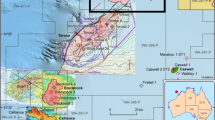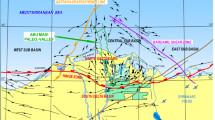Abstract
The low-frequency seismic reflection is important for the characterization of hydrocarbon reservoirs. Previous research has proved that the frequency-dependent component of the low-frequency reflection coefficient is approximately proportional to the reservoir fluid mobility. A low-frequency seismic attribute is defined to extract an approximate measurement of reservoir fluid mobility from seismic reflection data. Based on the high-resolution time–frequency decomposition technology, we apply this seismic attribute to detect hydrocarbons in shale and igneous reservoirs with low porosity and low permeability. The application results illustrate that the low-frequency seismic attribute can not only indicate the spatial distribution of oil and gas, which can help design the optimal landing point and trajectory of directional drilling, but also be approximately proportional to the production of oil and gas, which can be used for resource evaluation during the early exploration stage. We also give a brief discussion on the working mechanism of the low-frequency seismic attribute. The present work may provide some references for the subsequent exploration and research of reservoirs with low porosity and low permeability.









Similar content being viewed by others
References
Batzle M, Han D, Hofmann R (2006) Fluid mobility and frequency-dependent seismic velocity—direct measurements. Geophysics 71(1):1–9
Bhatti B, Brown R (2016) Low-frequency seismic analysis and direct hydrocarbon indicators. SEG Tech Program Expand Abstr 2051−2056
Biot MA (1956a) Theory of propagation of elastic waves in a fluid-saturated porous solid. I. Low-frequency range. J Acoust Soc Am 28(2):168–178
Biot MA (1956b) Theory of propagation of elastic waves in a fluid-saturated porous solid II Higher frequency range. J Acoust Soc Am 28(2):179–191
Buland A, Omre H (2003) Bayesian linearized AVO inversion. Geophysics 68(1):185–198
Castagna JP, Sun S, Siegfried RW (2003) Instantaneous spectral analysis: detection of low-frequency shadows associated with hydrocarbons. Lead Edge 22(2):120–127
Caudle BH, Dyes AB (1958) Improving miscible displacement by gas-water injection. Soc Petrol Eng 213(11):281–284
Chabyshova E, Goloshubin G (2014) Seismic modeling of low-frequency “shadows” beneath gas reservoirs. Geophysics 79(6):417–423
Chapman M, Liu E, Li XY (2006) The influence of fluid sensitive dispersion and attenuation on AVO analysis. Geophys J Int 167(1):89–105
Dasgupta R, Clark RA (1998) Estimation of Q from surface seismic reflection data. Geophysics 63(6):2120–2128
Dasios A, Astin TR, McCann C (2001) Compressional-wave Q estimation from full-waveform sonic data. Geophys Prospect 49(3):353–373
Ebrom D (2004) The low-frequency gas shadow on seismic sections. Lead Edge 23:772–772
Goloshubin GM, Van Schuyver C, Korneev V et al (2006) Reservoir imaging using low frequencies of seismic reflections. Lead Edge 25(5):527–531
Goloshubin GM (2000) Seismic low-frequency effects from fluid-saturated reservoir. SEG Tech Program Expand Abstr 1671−1674
Goloshubin, GM, Korneev, V, Vingalov, VM (2002) Seismic low-frequency effects from oil-saturated reservoir zones. SEG Tech Program Expand Abstr 1813–1816
Gurevich B, Zyrianov VB, Lopatnikov SL (1997) Seismic attenuation in finely layered porous rocks: effects of fluid flow and scattering. Geophysics 62(1):319–324
Han C, Jiang Z, Han M et al (2016) The lithofacies and reservoir characteristics of the Upper Ordovician and Lower Silurian black shale in the Southern Sichuan Basin and its periphery, China. Mar Pet Geol 75:181–191
He Z, Xiong X, Bian L (2008) Numerical simulation of seismic low-frequency shadows and its application. Appl Geophys 5(4):301–306
Hilterman F (2007) Advanced reservoir imaging using frequency-dependent seismic attributes. Dissertation, University of Houston
Huang HD, Zhang RW, Shen GQ et al (2011) Study of prestack elastic parameter consistency inversion methods. Appl Geophys 8(4):311–318
Huang HD, Wang YC, Guo F et al (2015) Zoeppritz equation-based prestack inversion and its application in fluid identification. Appl Geophys 12(2):199–211
Ji YZ, Yuan SY, Wang SX, Deng L (2016) Frequency-domain sparse Bayesian learning inversion of AVA data for elastic parameters reflectivities. J Appl Geophys 133:1–8
Korneev VA, Goloshubin GM, Daley TM, Silin DB (2004) Seismic low-frequency effects in monitoring fluid-saturated reservoirs. Geophysics 69(2):522–532
Lichman E, Goloshubin G (2003) Unified approach to gas and fluid detection on instantaneous seismic wavelets. SEG Tech Progr Expand Abstr 1699−1702
Liu L, Cao S, Wang L (2011) Poroelastic analysis of frequency-dependent amplitude-versus-offset variations. Geophysics 76(3):C31–C40
Rapoport MB, Rapoport LI, Ryjkov VI (2004) Direct detection of oil and gas fields based on seismic inelasticity effect. Lead Edge 23(3):276–278
Ren H, Goloshubin G, Hilterman FJ (2009) Poroelastic analysis of amplitude-versus-frequency variations. Geophysics 74(6):41–48
Shapiro SA, Müller TM (1999) Seismic signatures of permeability in heterogeneous porous media. Geophysics 64(1):99–103
Silin D, Goloshubin G (2010) An asymptotic model of seismic reflection from a permeable layer. Transp Porous Media 83(1):233–256
Silin DB, Korneev VA, Goloshubin GM, Patzek TW (2004) A hydrologic view on Biot's theory of poroelasticity. Lawrence Berkeley National Laboratory Report, Berkeley, California, USA
Taner MT, Koehler F, Sheriff RE (1979) Complex seismic trace analysis. Geophysics 44(6):1041–1063
Toksöz MN, Johnston DH, Timur A (1979) Attenuation of seismic waves in dry and saturated rocks: I. Lab Meas Geophys 44(4):681–690
Tonn R (1991) The determination of the seismic quality factor Q from VSP data: a comparison of different computational methods. Geophys Prospect 39(1):1–27
Wang Y (2007) Seismic time-frequency spectral decomposition by matching pursuit. Geophysics 72(1):V13–V20
Wang Y, Huang HD, Yuan S, Zhang S, Li BW (2016) Gas prediction using low-frequency components of variable-depth streamer seismic data applied to the deep water area of the South China Sea. J Nat Gas Sci Eng 34:1310–1320
White JE (1975) Computed seismic speeds and attenuation in rocks with partial gas saturation. Geophysics 40(2):224–232
White RS (1977) Seismic bright spots in the Gulf of Oman. Earth Planet Sci Lett 37(1):29–37
Xi Z, Tang S, Wang J (2018) The reservoir characterization and shale gas potential of the Niutitang formation: case study of the SY well in northwest Hunan Province, South China. J Petrol Sci Eng 171:687–703
Yuan SY, Wang SX, Ma M et al (2017) Sparse Bayesian learning-based time-variant deconvolution. IEEE Trans Geosci Remote Sens 55(11):6182–6194
Yuan SY, Liu Y, Zhang Z et al (2018) Prestack stochastic frequency-dependent velocity inversion with rock-physics constraints and statistical associated hydrocarbon attributes. IEEE Geosci Remote Sens Lett 16(1):140–144
Zhang H, Zhang R, Yang H et al (2014) Characterization and evaluation of ultra-deep fracture-pore tight sandstone reservoirs: a case study of Cretaceous Bashijiqike Formation in Kelasu tectonic zone in Kuqa foreland basin, Tarim, NW China. Petrol Explor Dev 41(2):175–184
Zeng J, Huang HD, Li HJ et al (2017) A fast complex domain-matching pursuit algorithm and its application to deep-water gas reservoir detection. J Geophys Eng 14(6):1335–1348
Acknowledgements
This work was financially supported by the Natural Science Foundation of China (41674139), the National Major Science and Technology Projects (2016ZX05033-033, 2017ZX05018-004-004). The field data were provided by Shenhua Group and Karamay oilfield. Jing Zeng would like to acknowledge China Scholarship Council.
Author information
Authors and Affiliations
Corresponding author
Ethics declarations
Conflict of interest
On behalf of all authors, the corresponding author states that there is no conflict of interest.
Appendices
Appendix 1
Review of harmonic solution to Eq. (1)
Substituting Eq. (2) into (1) yields
where \(E^{F} = \exp \left[ {i\left( {\omega t - k^{F} x} \right)} \right]\) and \(E^{S} = \exp \left[ {i\left( {\omega t - k^{S} x} \right)} \right]\). All the unknown parameters (k, U, P, Wo) in Eq. (1), corresponding to the fast and slow P-waves, satisfy the following equation
Simplify Eq. (13) to (14) by eliminating P.
where
Introduce some new variables as follows
Eliminate χ from Eq. (17) and acquire
The expressions of exact solutions to Eq. (18) are quite cumbersome. It is advisable to seek asymptotic solutions. Due to ε → 0 in low-frequency domain, Silin et al. (2004) approximated the solutions as the power series with respect to iε, i.e.,
Substitute Eq. (19) into (18), abandon the higher-order terms of iε and attain
Substitute Eq. (20) into (17) to estimate χ.
Finally, v, k, P and Wo can be estimated under the assumption that U is known, shown in Eqs. (3) and (4).
Appendix 2
Review of low-frequency reflection coefficient in porous media
Assuming that slow P-wave does not propagate and fast P-wave is normal incidence, we obtain Eq. (22) by virtue of Eqs. (4) and (6).
Simplify Eq. (22) by eliminating χ1 to the following expression
where \(X = \frac{{\beta_{1} }}{{\beta_{2} }}\frac{{v_{1} }}{{v_{f} }}\sqrt {\frac{{\gamma_{v} \gamma_{\rho } }}{{\gamma_{v} + 1}}} \sqrt \varepsilon\), \(Y = \frac{i - 1}{{\sqrt 2 }}\frac{{\phi_{1} \beta_{{f_{1} }} }}{{\phi_{2} \beta_{{f_{2} }} }}\frac{{v_{1} }}{{v_{f} }}\gamma_{v} \sqrt {\gamma_{v} + 1}\), \(Z = \left( {\gamma_{v} + 1} \right)\), and v1 = ω/k1 is the velocity of incident P-wave, which can be viewed as a constant. By solving Eq. (23), we can attain the asymptotic expression for the low-frequency reflection coefficients of incident P-wave
where
Multiplying simultaneously the numerator and the denominator of Eq. (24) by (c + b + e√ε), and then ignoring the terms of order ε yields
which can also be written as Eq. (7).
Rights and permissions
About this article
Cite this article
Zeng, J., Huang, H., Yuan, S. et al. Low-porosity and low-permeability reservoirs characterization using low-frequency seismic attribute. Acta Geophys. 68, 1345–1360 (2020). https://doi.org/10.1007/s11600-020-00474-5
Received:
Accepted:
Published:
Issue Date:
DOI: https://doi.org/10.1007/s11600-020-00474-5




